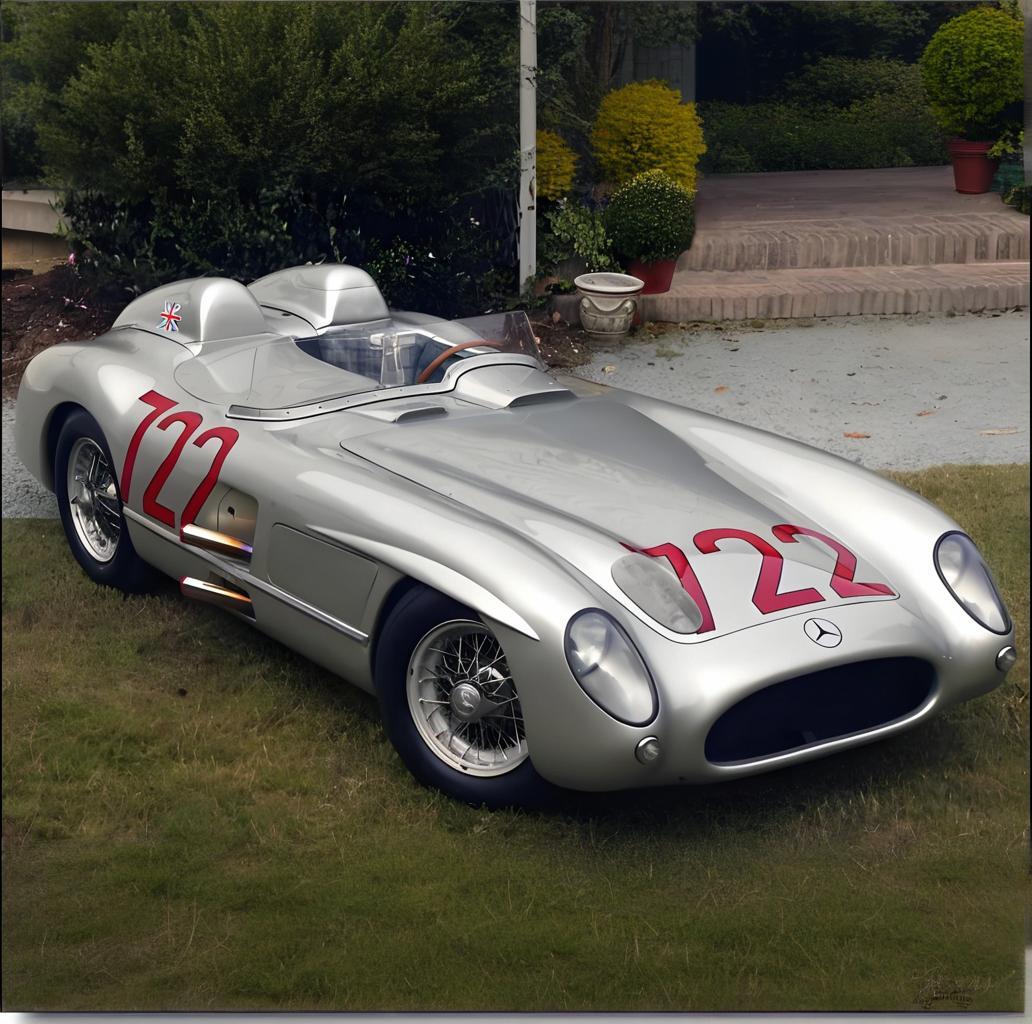At 7:22 in the morning of May 1, 1955, a silver arrow with a bright red number "722" set off from Brescia, Italy, crossing thousands of kilometers of roads, cities and mountains, and the end point was glory. This is not a fictional plot, but a chapter in history written by Stirling Moss and his co-driver Denis Jenkinson driving the Mercedes-Benz 300 SLR in the Mille Miglia race - 10 hours, 7 minutes and 48 seconds, an average speed of 157.6 km/h, a race record that has not been broken to this day! Silver Arrow Warhorse Born for the Road
Silver Arrow Warhorse Born for the Road
You may be surprised that a racing car used for competition is equipped with turn signals, headlights and license plates? The Mercedes-Benz 300 SLR is indeed an anomaly. It was developed based on the F1 W196 R racing car, but was designed for long-distance road racing. Therefore, it has road certification and can legally compete on closed roads. It also retains a large number of practical equipment, showing Mercedes' philosophy of both practicality and technology in racing.
The dashboard is full of control devices. The left knob controls the ignition and lighting system, and the right side has a turn signal switch and various warning lights. In the center is the eye-catching Veglia tachometer, with a red zone at 7,000 rpm and a maximum horsepower of 276. There is no speedometer, only one belief: to move forward at the limit.
Legend, only that year
This 300 SLR only participated in the race for one year, but it not only helped Mercedes win the 1955 World Sportscar Championship, but also helped Fangio win his second F1 World Championship. However, this glorious year also brought a painful price - the tragedy of Le Mans took 83 lives. Mercedes finally withdrew from the track at the end of the year and turned its focus to the development of civilian cars.
Absolute control, absolute trust
Stirling Moss deliberately chose a three-spoke steering wheel to ensure that the instrument information can be fully seen. Even more interesting is the "D" logo on the rear of the racing car - it is actually a switch, which can be opened to open the trunk and take out the spare tire by flipping it up. This precision reflects the brand's ultimate craftsmanship. The interior configuration is as precise as a racehorse. The accelerator and brake pedals are located on the right side of the drive shaft, while the clutch is independent on the left side. The drive shaft can reach a high speed of 7,800 rpm. The seats are made of blue plaid Gabardine fabric, which echoes the 300 SL Gullwing. Moss was given a steering wheel as a souvenir after winning the race. This design is now reproduced in the Museum.
The interior configuration is as precise as a racehorse. The accelerator and brake pedals are located on the right side of the drive shaft, while the clutch is independent on the left side. The drive shaft can reach a high speed of 7,800 rpm. The seats are made of blue plaid Gabardine fabric, which echoes the 300 SL Gullwing. Moss was given a steering wheel as a souvenir after winning the race. This design is now reproduced in the Museum.
Co-pilot Jenkinson sits on a slightly lower and narrower seat. In front of him is a metal mechanical reel that stores the carefully written road book and provides real-time navigation between narrow roads, highways and turns. It is the most important "technological weapon" behind the victory in 1955.
Stirling Moss's Eternal Silver Arrow
Moss and "722" were together all his life. He once said: "This is the most perfect racing car ever." In 2005, he signed on the front of the car: "We did it together - my thanks and affection". After his death in 2020, Mercedes-Benz filmed a short film "The Last Blast" to travel through London with this car to bid farewell to this legend. In addition to surpassing the limits, the 300 SLR "722" witnessed the transformation of racing culture and the emotional bond between people and cars. Stirling Moss not only won the time in the race, he turned a machine into a soulful comrade-in-arms. This spirit and craftsmanship are the core of the immortality of the Mercedes-Benz century-old brand. Today, when we talk about technology, performance, and brand value, without these stories that carry history and glory, everything is just a game of numbers. And "722" reminds us that legend is not about speed, but about faith.
In addition to surpassing the limits, the 300 SLR "722" witnessed the transformation of racing culture and the emotional bond between people and cars. Stirling Moss not only won the time in the race, he turned a machine into a soulful comrade-in-arms. This spirit and craftsmanship are the core of the immortality of the Mercedes-Benz century-old brand. Today, when we talk about technology, performance, and brand value, without these stories that carry history and glory, everything is just a game of numbers. And "722" reminds us that legend is not about speed, but about faith.
Categories: vehicles
